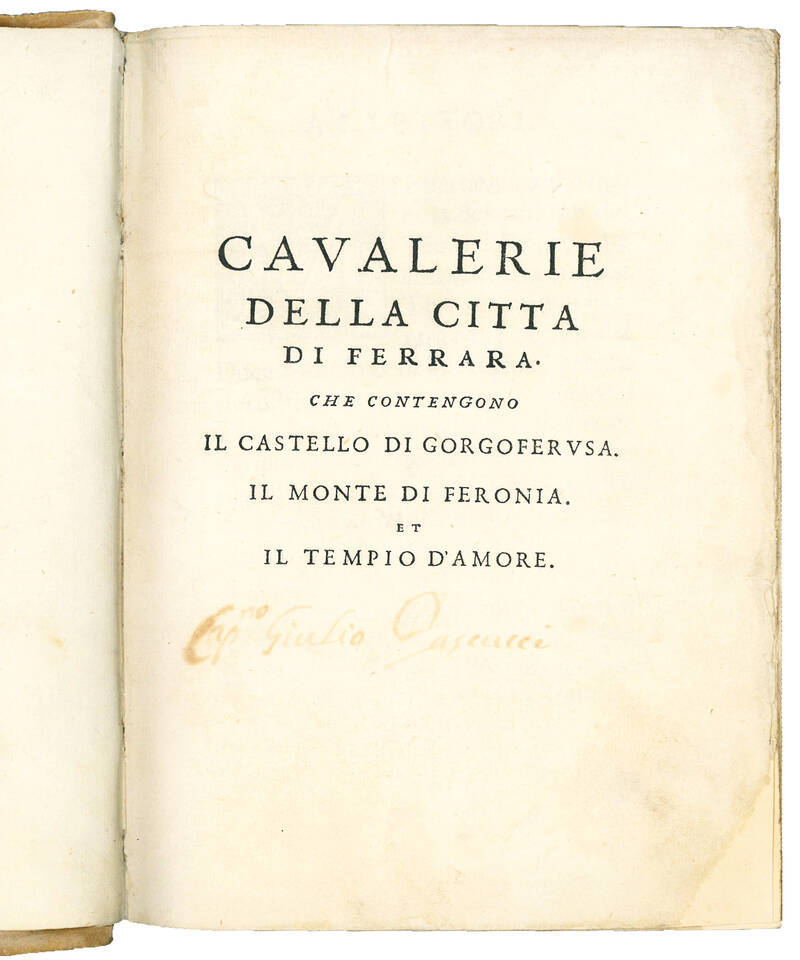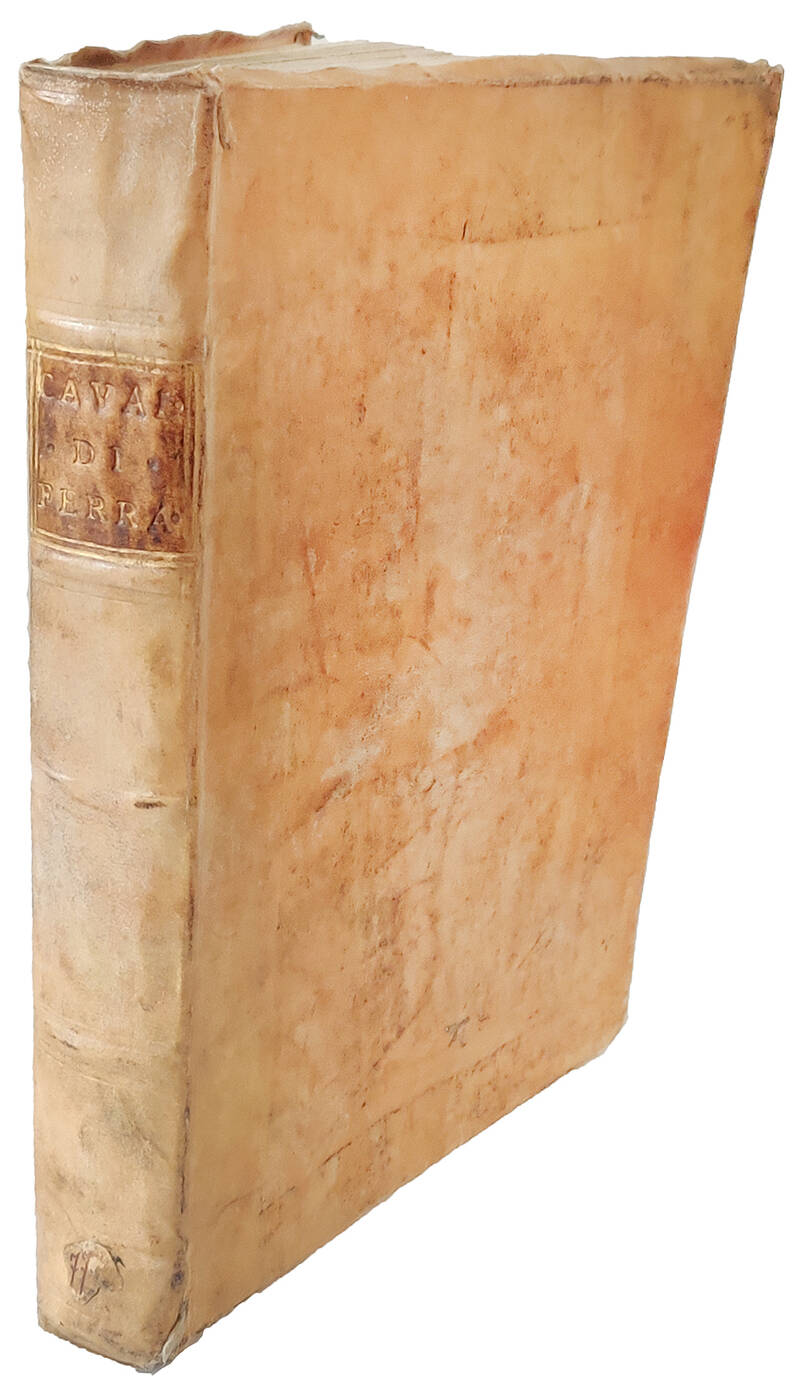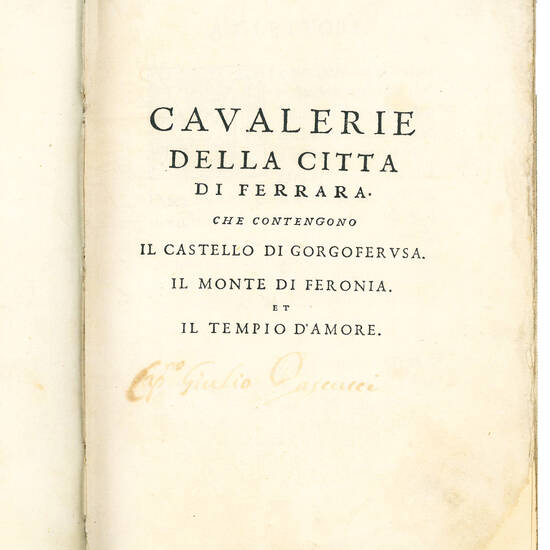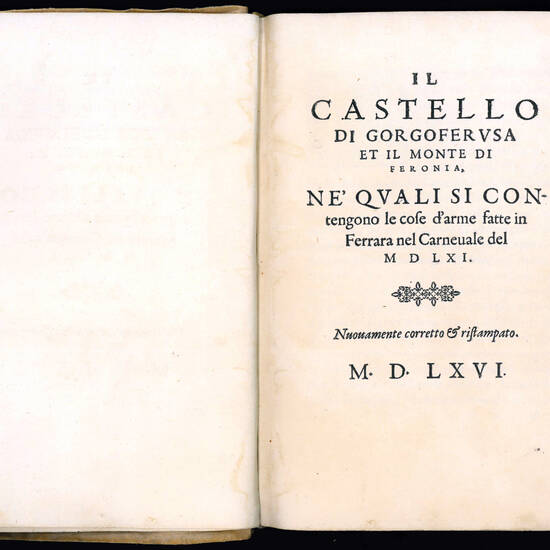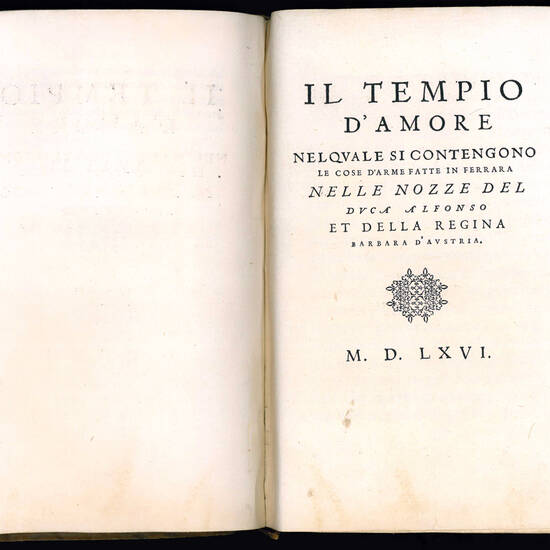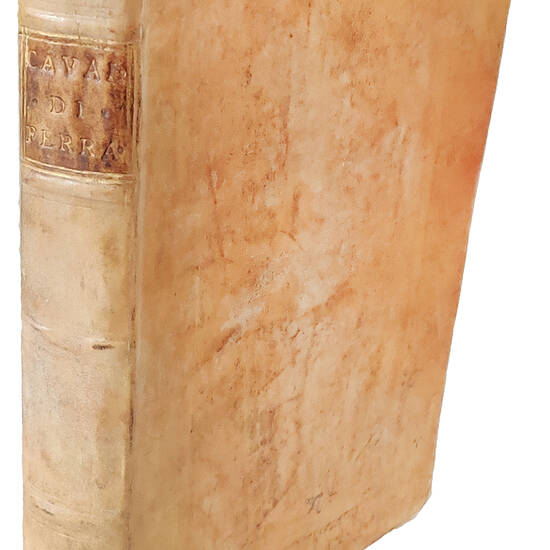Two parts in one volume, 4to (220x160 mm). [2], 55, [1] leaves; [8], 181, [19] pp. Collation: [π]² A-O4; +4 A-Z42+4 ++4. Leaves O4 of part one, +4 and Z4 of part two are blank. There is a general title page and a section title page for each part. Roman and italic types. Woodcut historiated initials. 17th-century limp vellum, lettering piece on spine (endleaves renewed). On first title page ownership inscription “Cap.no Giulio Gascucci (or Pascucci)”. Small restoration to the lower outer margin of the first ten leaves not affecting the text, otherwise a clean and wide-margined copy printed on thick paper.
First collective edition (Il Monte di Feronia and Il Castello di Gorgoferusa had already been printed at Venice in 1561). The first two pieces are attributed to Agostino Argenti (cf. A. Solerti, Ferrara e la corte estense nella seconda metà del secolo decimosesto, Città di Castello, 1900, pp. XXVIII-XXXIX), whereas the newly added Tempio d'Amore to Giovanni Battista Pigna (cf. R. Baldi, Giovanni Battista Pigna, uno scrittore politico nella Ferrara del Cinquecento, Genoa, 1983, p. 35).
In Ferrara under the late Este dukes the tournament was developed to its highest form of elaboration as the old format of ‘defi par cartel' gradually gave way to the ‘tournoi à theme'. The Este court had always been open to northern influences, and was fountainhead from whence flowed chivalric practice in its new renaissance guise. Ferrara, too, was seminal for the marriage of the ingredients of a Greco-Latin humanist culture to the mythology of romance civilization from north of the Alps. In the 1560s under Duke Alfonso II, a series of ‘tournois à the-me' were staged. In these, sustained plots, carefully conceived in philosophical and symbolic terms under the supervision of the leading poets of the day, were adorned with complex stage machinery, a range of literary forms embracing verse, dialogue and monologue besides sung and instrumental music, all on a scale which anticipates not only the equestrian set pieces of the baroque age, but also opera (cf. I. Mamczarz, Gli spattacoli cavallereschi a Ferrara del Cinquecento, in: “Il teatro italiano del Rinascimento”, Milan, 1980, pp. 425-458).
Il Monte di Feronia was staged on the occasion of a visit to the court by Francesco de' Medici. It was performed in the courtyard of the Palazzo Ducale on March 27, 1561, utilizing the same stage and scenery as Il Castello di Gorgoferusa just three weeks previously. It included all the ingredients of the normal Baroque tourney: an introduction set to music, a pre-arranged contest in an arena surrounded by spectators between a number of squadrons on horseback accompanied by many supernumeraries possibly in chariots or carriages, a raised stage with movable scenery, music and musicians, some in costume. “Il torneo regge sulla base di un'articolata finzione. La ‘regina di Alfarabia' si fa annunciare nella città di Ferrara per raccontare le sventure del suo consorte, Colocauro, re di Panticapea, dal nemico preso e fatto prigioniero. Vengono in seguito stabilite delle intricate regole di combattimento per effettuare la sua liberazione, con definizione dei premi, dei rischi e quant'altro. Così viene creato un fantasioso pretesto per l'esecuzione di tradizionali prassi cavalleresche, che qui diventano parte integrante di una non troppo concentrate azione drammatica. In tal modo gli attori, i musicisti, insomma gli artisti, finiscono per ‘collaborare' con più schiere di cavalieri ferraresi nel contesto di uno spettacolo straordinariamente eterogeneo. Il ruolo non trascurabile riservato alla musica emerge con chiarezza da un'attenta lettura della summenzionata descrizione. Abbondano i riferimenti al canto e al suono, anche se non spunta il nome di alcun musicista” (T. Walker, Echi estensi negli spettacoli musicali a Ferrara nel primo Seicento, in: “La Corte di Ferrara e il suo mecenatismo 1441-1598. The Court of Ferrara & its Patronage. Atti del convegno internazionale, Copenaghen maggio 1987”, M. Pade, L. Waage Petersen & D. Quarta, eds., Modena, 1990, pp. 338-339).
Il Tempio d'Amore was staged during the wedding festivities of Alfonso d'Este and Barbara of Austria on December 11, 1565 (cf. I. Mamczarz, Une fête équestre à Ferrare ‘Il tempio d'Amore', 1565, in: “Les fêtes de la Renaissance”, J. Jacquot, ed., Paris, 1975, III, pp. 349-372). “L'impostazione del Tempio d'Amore si discosta poco da quella del Monte di Feronia: I principali ingredienti sono sempre gli stessi, e fra questi figura la musica in misura semmai crescente […] Più numerosi, rispetto al primo caso esaminato, sono quei testi dei brani cantata riprodotti nella stampa […] Talvolta il canto fu associate al ballo […] Non poteva mancare, in fine di spettacolo, un madrigale, lunghissimo, in celebrazione delle due famiglie unite in matrimonio […] La descrizione contiene ancora poesia in abbondanza, compreso qualche raro esempio di versi misurati” (T. Walker, op. cit., pp. 340-342)
Agostino Argenti, a native of Ferrara, distinguished himself at an early age as a poet and soon acquired a position at the Estense court. Apart the account and text for the tournaments described in the Cavalerie della Città di Ferrara, he was also the author of a pastoral play Lo Sfortunato, staged at Ferrara in March 1567, which greatly influenced the Aminta of Torquato Tasso (cf. M. Quattrucci, Argenti, Agostino, in: “Dizionario Biografico degli Italiani”, IV, Rome, 1962, pp. 155-156).
Giovanni Battista Pigna was born at Ferrara, where he made his early studies under Lilio Gregorio Giraldi and Battista Guarini. At the age of twenty he became a teacher at the ‘Studio' of Ferrara and later secretary, chancellor and historiographer to Alfonso II d'Este. He was the author of Il duello (1554), a treatise on honor and the qualities of a gentleman, the Romanzi (1554) on the epic poem, a history of the house of Este (1570), and an important treatise on stagecraft, Il Principe (1561), dedicated to duke Emanuele Filiberto of Savoy, but originally written for Alfonso d'Este, when he still was a young prince (cf. R. Baldi, op. cit., passim).
Edit 16, CNCE10442; Adams F-265; Index Aureliensis, 107.239; C. Fahy, Le edizioni di Francesco Rosso, in: “L'Orlando Furioso del 1532. Profilo di una edizione”, Milan, 1989, p. 186; H. Watanabe-O'Kelly & A. Simon, Festivals and Ceremonies: Bibliography of Works Relating to Court, Civic and Religious Festivals in Europe, 1500-1800, London, 2000, p. 390, no. 388.
[12750]

